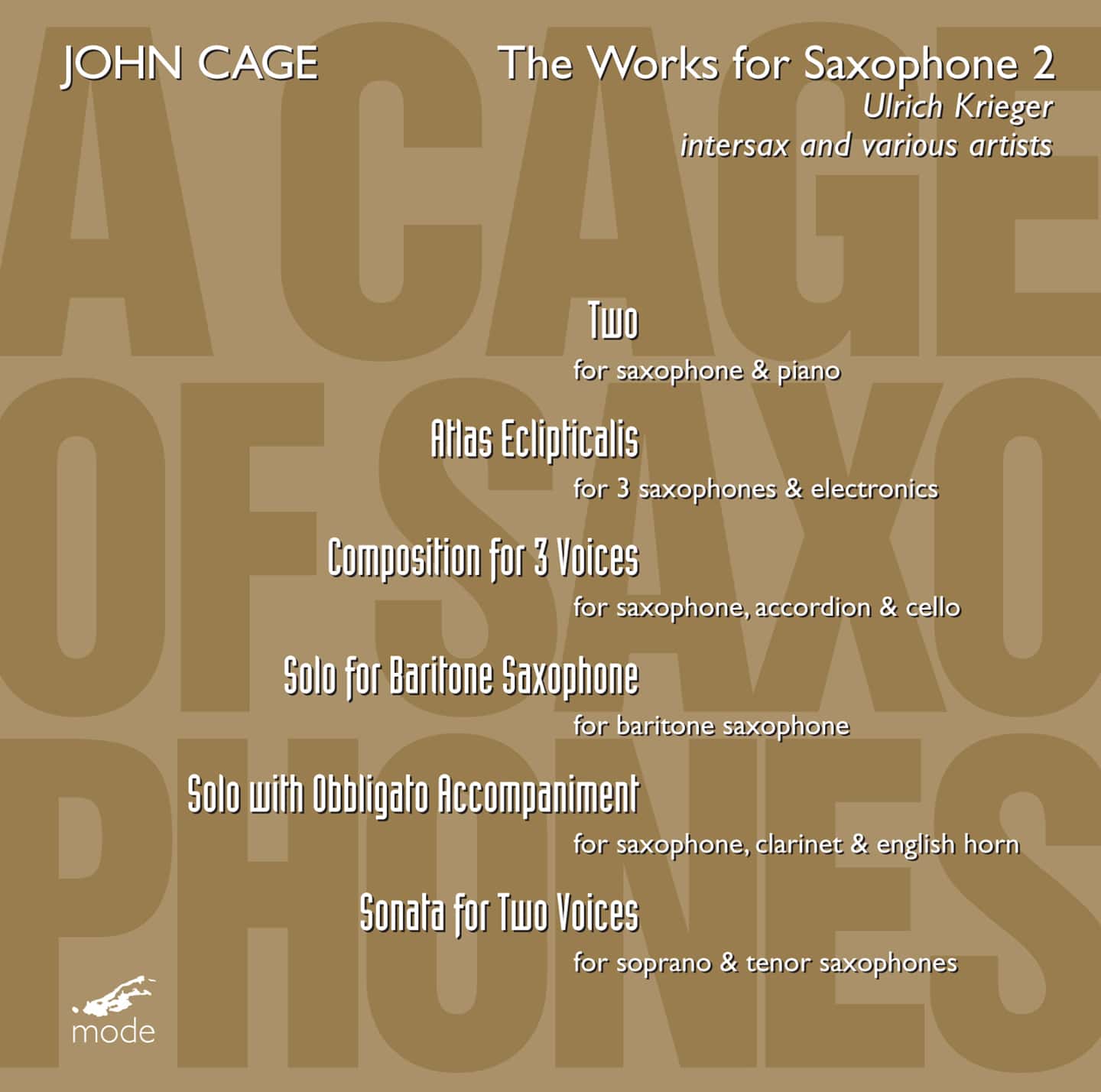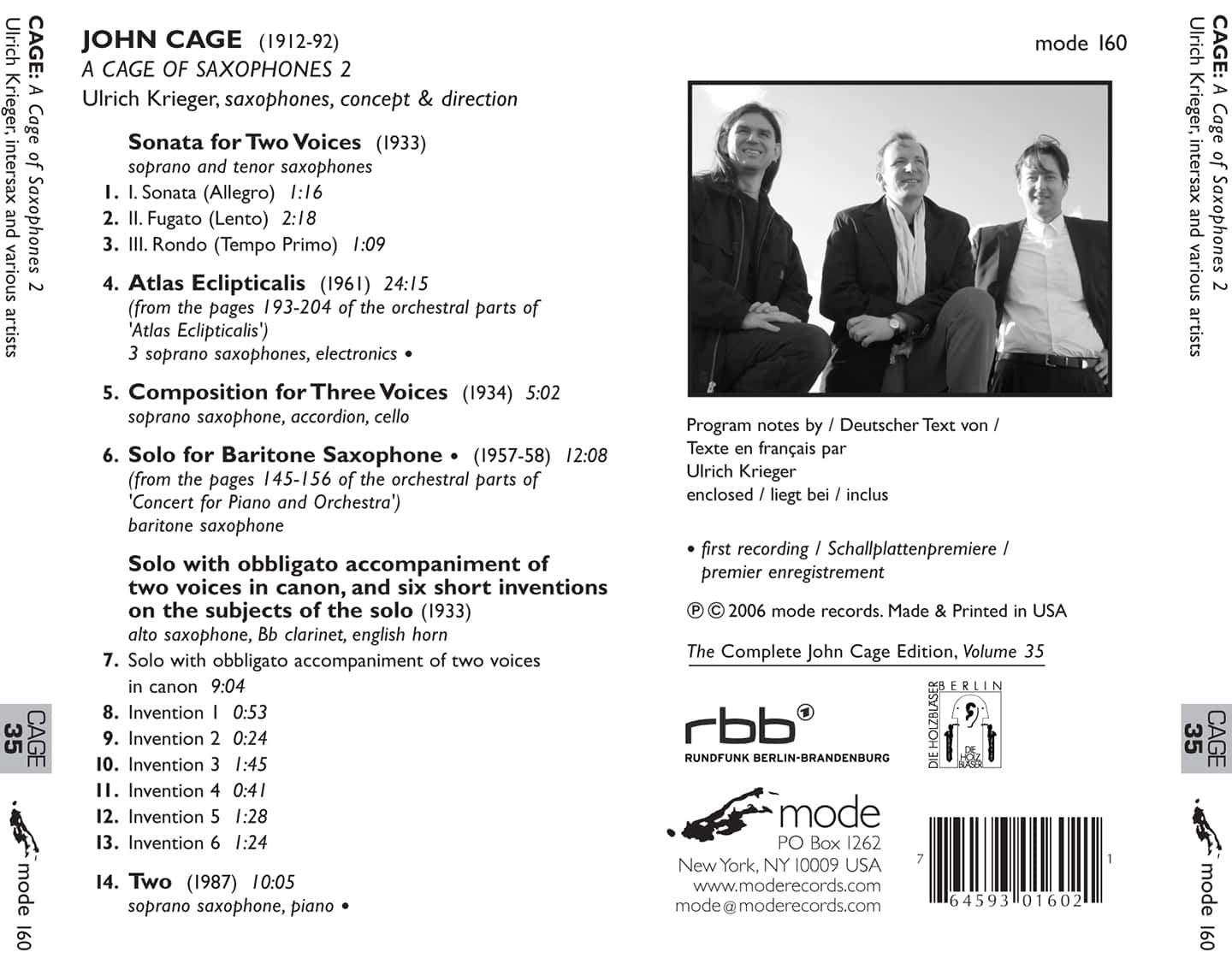Cage Edition 35–A Cage Of Saxophones 2
(viewed Feb. 7, 2013). Intersax (Ulrich Krieger, soprano saxophone, alto saxophone, baritone saxophone ; Tobias Rger, soprano saxophone, tenor saxophone ; Reimar Volker, soprano saxophone) ; guest artists: Volker Straebel, electronics ; Gerald Scherer, accordion ; Ulrich Maiss, cello ; Erich Wagner, clarinet ; Brigit Schmieder, English horn ; Mario Bertoncini, piano. Recorded in 2003. Previously released as a compact disc.
Ulrich Krieger, saxophones, concept & direction
Sonata for Two Voices (1933)
soprano and tenor saxophones
Sonata (Allegro) (1:16)
Fugato (Lento) (2:18)
Rondo (Tempo Primo) (1:09)
Atlas Eclipticalis (1961) (24:15)*
(from the pages 193-204 of the orchestral parts of ‘Atlas Eclipticalis’)
3 soprano saxophones, electronics
Composition for Three Voices (1934) (5:02)
soprano saxophone, accordion, cello
Solo for Baritone Saxophone (1957-58) (12:08)*
(from the pages 145-156 of the orchestral parts of ‘Concert for Piano and Orchestra’)
baritone saxophone
Solo with obbligato accompaniment of two voices in canon, and six short inventions on the subjects of the solo (1933)
alto saxophone, Bb clarinet, english horn
Solo with obbligato accompaniment of two voices in canon (9:04)
Invention 1 (0:53)
Invention 2 (0:24)
Invention 3 (1:45)
Invention 4 (0:41)
Invention 5 (1:28)
Invention 6 (1:24)
Two (1987) (10:05)*
soprano saxophone, piano
* first recordings
Ulrich Krieger follows up his successful A Cage of Saxophones 1 volume with the second installment of Cage works for saxophone(s), spanning a period of over 50 years.
For this volume, Krieger combines works specifically composed for saxophone with works of no specified instrumentation that are suited for saxophones and winds.
This CD collects three rarely heard early works, all written without indications for specific instruments. Krieger has arranged them here for his ensemble of saxophones and other instruments.
For the middle period works, Krieger has excerpted the solo instrumental parts related to saxophones from the scores to Concert for Piano and Orchestra and Atlas Eclipticalis – Cage permitted the option for the various instrumental parts to be performed as solos.
The late works are covered by Two, originally composed for flute and piano, here premiered in the Cage sanctioned version for saxophone.
Acclaimed German saxophonist Ulrich Krieger studied classical/contemporary saxophone, composition, and electronic music at the Hochschule der Künste (Berlin) and the Manhattan School of Music (New York). Since 1990 he works freelance as interpreter, improviser, composer, and rock musician. He worked with leading artists such as LaMonte Young, Phill Niblock, David First, Lee Ranaldo, Elliott Sharp, Mario Bertoncini, Merzbow, and many others.
Here’s what the critics said about Volume 1:
“These are beautifully refined performances of late Cage pieces involving saxophones…and the ensemble playing is remarkable, even telepathic.”
— Clive Bell, The Wire, May 2002
“Uli Krieger’s colours are absolutely flawless, his use of technique never overwhelming but always in line with the necessary attention to every detail. This is a superb recording!”
— Massimo Ricci, Touching Extremes, December 2002
Reviews
John Cage
The Piano Works 7
Margaret Leng Tan (piano)
Mode 158
John Cage
A Cage of Saxophones 2
Ulrich Krieger & Other Artists
Mode 160
The view that another recording of Sonatas and Interludes for Prepared Piano (now 60 years old) is the last thing anyone needs right now ignores the vividness and precision of the version, performed by Margaret Leng Tan. The opening will turn heads: a peal of chimes that contrasts sharply with even the approved versions by Maro Ajemian and others. As Eric J Bruskin points out in his liner notes, it’s extraordinary that no one before Tan seems to have read the score closely enough to use the prescribed damper pedal for those famous chords. Cage, of course, laid down some of his preparations very exactly and others with apparent indifference. There’s a myth that he prescribed the sound of the Sonatas and Interludes very exactly. In fact, every performance differs, but this one seems more different than most and, for the moment at least, definitive. There’s an extra dimension in the chirping of a cricket at intervals.
The other bonus of this set is the rediscovery of Chess Pieces, a score abstracted from a Cage painting included in the Imagery of Chess exhibition in New York in 1944 (the score went on public view last October for the first time). The piece is a Satie-esque lightweight, 22 little modules of 12 bars, conventionally read. The other amuse-bouche is Vittorio Rieti’s Chess Serenade from the same show.
Performed by Ulrich Krieger, A Cage of Saxophones 2 deals with late works, going right back to the beginnings with the Sonata for Two Voices from 1933 (done here on soprano and tenor), Composition for Three Voices from the following year for soprano, accordion and cello, and Solo with Obbligato Accompaniment of Two Voices in Canon played on alto, B flat clarinet and cor anglais. Clarinettist Erich Wagner and double reed specialist Birgit Schmieder guest on the last piece; elsewhere Krieger is joined by Tobias Ruger and Reimar Volker, all three of them playing sopranos on a superb excerpt from Atlas Eclipticalis. The highlight of the set is Krieger’s baritone solo derived from the orchestral parts of the 1957-58 Concert For Piano and Orchestra, one of Cage’s most important pieces of the period.
Episodic these recordings may be, but they help fill in more and more of the Cage canon and underline its inexhaustibility. The early works also act as a useful reminder of how much his language and procedures derived from the Second Viennese School.
— Brian Morton, The Wire, July 2, 2006
John Cage
A Cage of Saxophones 2
Ulrich Krieger with other artists
Mode 160
The 35th volume in Mode’s Complete John Cage Edition is also the second release in Ulrich Krieger’s series of interpretations for solo saxophone and saxophones with other instruments. Ensemble pieces of comparatively large dimensions were gathered on A Cage of Saxophones: Vol. 1, so this follow-up disc presents pieces for smaller combinations and solos, though with no less originality or charm. Even though most of these works were composed for open instrumentation, saxophones suit Cage’s music especially well, not only because of their clean tone quality, wide dynamic range, and exceptional variety of timbres, but also because of their interesting associations with jazz and modernism. Listeners may be excused for thinking the opening “Sonata for Two Voices” (1933) is a little like bebop avant la lettre, and the “Composition for Three Voices” (1934) offers an example of the young composer’s serious-minded counterpoint, not too far removed from Stravinsky’s “objective” examples. But the Cage most will recognize is found in the mature works, “Solo for Baritone Saxophone” (1957-1958) and the adaptation for three soprano saxophones and electronics of a portion of “Atlas Eclipticalis” (1961); these works are more spacious and contemplative in their long silences and briefly held pitches, and the control Krieger displays in the softest passages makes his performances utterly compelling. Because the more conventional compositions of the 1930s are in a completely different style than the later, more expansive works, some listeners may feel the need to skip around to find tracks to suit their mood; listening to the CD straight through produces an oddly unsettling and expectant feeling that seems inappropriate for the timeless stillness and sublime aesthetics one associates with Cage at his purest. Mode’s sound quality is, as usual, excellent.
— Blair Sanderson, All Music Guide 2006
Links
Ulrich Krieger on Mode:
Luciano Berio: The Complete Sequenzas and Works for Solo Instruments (mode 161-163)
Gavin Bryars: The Marvellous Aphorisms of Gavin Bryars: The Early Years (mode 177)
John Cage: A Cage of Saxophones, Volume 1 (mode 104)
John Cage: A Cage of Saxophones, Volume 2 (mode 160)
John Cage: A Cage of Saxophones, Volumes 3 & 4 (mode 222/223)
Ulrich Krieger: [urban dreamings] (mode 282)
John Cage Profile
Ulrich Krieger Profile
Tobias Rüger Profile
Reimar Volker Profile


